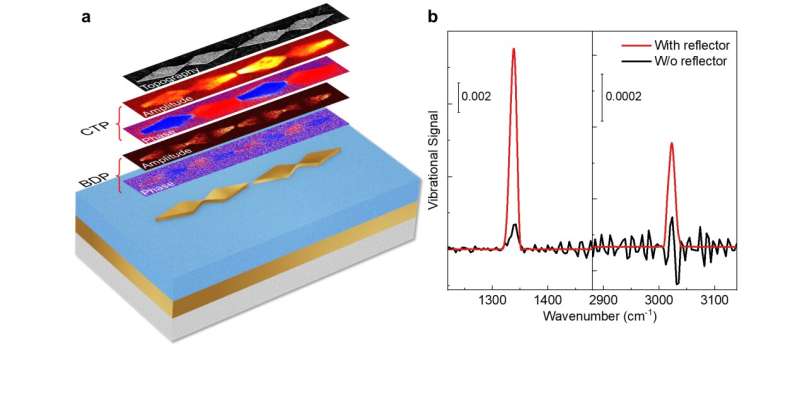Nanobridged rhombic antennas that support both dipolar and high-order plasmonic modes

In a new publication from Opto-Electronic Advances, the research groups of Professor Zhong-Qun Tian from Xiamen University, Xiamen, China and Professor Huigao Duan from Hunan University Changsha, China discuss nanobridged rhombic antennas supporting both dipolar and high-order plasmonic modes with spatially superimposed hotspots in the mid-infrared.
Mid-infrared antennas (MIRAs), often constructed from metals (e.g., Au, Al or Ag), highly doped III-V semiconductors, electron-doped graphene or phonon-polariton-based nanostructures, support optical resonance in the mid-infrared spectral range (400 to 4000 cm−1). MIRAs can act as receiving antennas thereby concentrating mid-infrared beams from free space to nanoscale regions (termed as hotspots) in the vicinity of the surface of MIRAs. MIRAs can also act as a transmitting antennas to directionally amplifying thermal radiation produced by local heating of sources coupled to MIRAs. These impressive features of MIRAs have inspired a wide range of investigation of their potential applications for surface-enhanced infrared absorption (SEIRA) spectroscopy leading to ultrahigh sensitivities (up to hundreds of oscillators), for biological and chemical sensors in the mid-infrared region, for beam-shape engineering of quantum cascade lasers, and for highly-responsive photodetectors with enhanced absorption and photocarrier collection efficiency in the mid-infrared. The core elements for the high-performance applications are the MIRA micro- and nanostructures, but the development of MIRA structures lags far behind that of optical antenna nanostructures in the visible spectral range.
Single-arm dipolar-antenna structures are among the most classical MIRAs, often consisting of gold rods with tunable resonant wavelengths by tuning the length of the rods. Furthermore, dual-arm dipolar-antennas with nanometer-sized gaps (nanogaps), such as gold rod dimers, have also been developed on account of the strength of the local field enhancement factors in their nanogaps. Nevertheless, both single-arm and dual-arm dipolar-antennas usually support only the dipolar resonance mode which is a fundamental and narrow-band mode with a typical bandwidth around 200–500 cm−1. Usually, high-order modes in single-arm or dual-arm are typically too weak in the optical spectra. This feature limits the application demanding multiple resonances in MIR region.
To obtain multiband MIRAs, several micro- and nanostructures beyond single-arm or dual-arm antennas have been designed, among them, gold nano-crosses, nanoaperture structures, fractal microstructures, log-periodic trapezoidal structures, and dipolar antennas with multiple lengths. These structures could be categorized into the micro- and nanostructures supporting several dipolar modes. Fundamentally, it is a long-term challenge to develop single-arm or dual-arm antennas supporting simultaneously pronounced fundamental and high-order plasmonic modes such as a quadrupolar mode.
The research group of Professor Zhong-Qun Tian from Xiamen University and Professor Huigao Duan from Hunan University designed and fabricated a multiscale nanobridged rhombic antenna (NBRA, Fig. 1a) that supported two dominant resonances in the MIR (Fig. 1b), including a charge-transfer plasmon (CTP) band and a bridged dipolar plasmon (BDP) band which looks like a quadruple resonance. These assignments are evidenced by scattering-type scanning near-field optical microscopy (s-SNOM) imaging and electromagnetic simulations. Comparing with other nanobridged structures, such as nanobridged-disks or rectangles, the NBRA shows distinct multiband resonances in the mid-infrared region in the simulated extinction spectra. Further, the hotspots of the NBRA are located at the extremities of the structure, while the hotspots of nanobridged-disks or rectangles at the CTP resonance are distributed dispersively. The high-order band only occurs with nanometer-sized bridge (nanobridge) linked to the one end of the rhombic arm which mainly acts as the inductance and the resistance by the RLC circuit analysis. Moreover, the main hotspots associated with the two resonant bands are spatially superimposed, enabling boosting up the local field for both bands by multiscale coupling. With large field enhancements, multiband detection with high sensitivity to a monolayer of molecules is achieved when using SEIRA spectroscopy. This work provides a new strategy to activate high-order modes for designing multiband MIRAs with both nanobridges and nanogaps for such MIR applications as multiband SEIRAs, IR detectors, and beam-shaping of quantum cascade lasers in the future.
More information: En-Ming You et al, Nanobridged rhombic antennas supporting both dipolar and high-order plasmonic modes with spatially superimposed hotspots in the mid-infrared, Opto-Electronic Advances (2021). DOI: 10.29026/oea.2021.210076
Provided by Compuscript Ltd




















